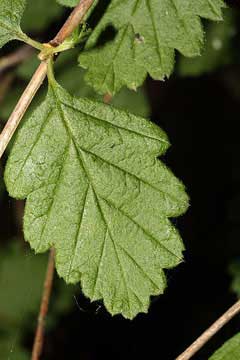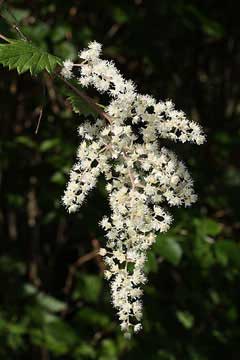 |
|
http://commons.wikimedia.org/wiki/User:Wsiegmund |
 |
| http://commons.wikimedia.org/wiki/User:Wsiegmund |
Translate this page:
Summary
Physical Characteristics

 Holodiscus discolor is a deciduous Shrub growing to 3 m (9ft) by 3 m (9ft) at a fast rate.
Holodiscus discolor is a deciduous Shrub growing to 3 m (9ft) by 3 m (9ft) at a fast rate.
See above for USDA hardiness. It is hardy to UK zone 5. It is in flower in July, and the seeds ripen in October. The species is hermaphrodite (has both male and female organs) and is pollinated by Insects.
Suitable for: light (sandy), medium (loamy) and heavy (clay) soils. Suitable pH: mildly acid, neutral and basic (mildly alkaline) soils. It can grow in semi-shade (light woodland) or no shade. It prefers moist soil.
UK Hardiness Map
US Hardiness Map
Synonyms
Sericotheca discolor. Spiraea discolor. S. ariaefolia.
Plant Habitats
Woodland Garden Sunny Edge; Dappled Shade;
Edible Uses
Edible Parts: Fruit
Edible Uses:
Fruit - raw or cooked[106, 177, 183]. Small and dry[161, 183].
References More on Edible Uses
Medicinal Uses
Plants For A Future can not take any responsibility for any adverse effects from the use of plants. Always seek advice from a professional before using a plant medicinally.
Blood purifier Ophthalmic Poultice Skin Tonic
The seeds are a blood purifier[257]. An infusion has been used in the treatment of smallpox, black measles and chickenpox[257]. The blossoms have been used in the treatment of diarrhoea[257]. The inner bark is tonic[257]. An infusion has been used as an eyewash[257]. The bark can be dried, powdered and then used with oil as a dressing on burns[257]. A poultice of the leaves has been applied to sore lips and sore feet[257]. A powder of the dried leaves has been used as a dressing on sores[257]. A decoction of the leaves has been used in the treatment of influenza[257].
References More on Medicinal Uses
The Bookshop: Edible Plant Books
Our Latest books on Perennial Plants For Food Forests and Permaculture Gardens in paperback or digital formats.

Edible Tropical Plants
Food Forest Plants for Hotter Conditions: 250+ Plants For Tropical Food Forests & Permaculture Gardens.
More

Edible Temperate Plants
Plants for Your Food Forest: 500 Plants for Temperate Food Forests & Permaculture Gardens.
More

More Books
PFAF have eight books available in paperback and digital formats. Browse the shop for more information.
Shop Now
Other Uses
Wood
Wood - very hard. Used for making small tools, roasting tongs etc[118]. It does not burn easily[118].
Special Uses
Scented Plants
References More on Other Uses
Cultivation details
Succeeds in a good loamy soil that does not become too dry in summer, in full sun or light shade[200]. A fast-growing plant[188], it thrives in thin woodland[11]. A very ornamental plant[1, 11], when fully dormant it is hardy to about -15°c[200], though the young growth in spring can be damaged by late frosts[K]. The flowers emit a perfume similar to meadowsweet[245].
References Carbon Farming Information and Carbon Sequestration Information
Temperature Converter
Type a value in the Celsius field to convert the value to Fahrenheit:
Fahrenheit:
The PFAF Bookshop
Plants For A Future have a number of books available in paperback and digital form. Book titles include Edible Plants, Edible Perennials, Edible Trees,Edible Shrubs, Woodland Gardening, and Temperate Food Forest Plants. Our new book is Food Forest Plants For Hotter Conditions (Tropical and Sub-Tropical).
Shop Now
Plant Propagation
The seed requires 4 months stratification at 4°c. It is best sown as soon as it is ripe in a cold frame. Stored seed should be sown as early in the year as possible. When they are large enough to handle, prick the seedlings out into individual pots and grow them on in the greenhouse for at least their first winter. Plant them out into their permanent positions in late spring or early summer, after the last expected frosts. Cuttings of half-ripe wood with a heel, July/August in a frame. Can be difficult[200]. Layering in spring. Easy[200].
Other Names
If available other names are mentioned here
Native Range
NORTHERN AMERICA: Canada (British Columbia (south)), United States (Idaho, Montana (west), Oregon, Washington, California)
Weed Potential
Right plant wrong place. We are currently updating this section.
Please note that a plant may be invasive in one area but may not in your area so it's worth checking.
Conservation Status
IUCN Red List of Threatened Plants Status :

Growth: S = slow M = medium F = fast. Soil: L = light (sandy) M = medium H = heavy (clay). pH: A = acid N = neutral B = basic (alkaline). Shade: F = full shade S = semi-shade N = no shade. Moisture: D = dry M = Moist We = wet Wa = water.
Now available:
Food Forest Plants for Mediterranean Conditions
350+ Perennial Plants For Mediterranean and Drier Food Forests and Permaculture Gardens.
[Paperback and eBook]
This is the third in Plants For A Future's series of plant guides for food forests tailored to
specific climate zones. Following volumes on temperate and tropical ecosystems, this book focuses
on species suited to Mediterranean conditions—regions with hot, dry summers and cool, wet winters,
often facing the added challenge of climate change.
Read More
Expert comment
Author
(Pursh.)Maxim.
Botanical References
1171200
Links / References
For a list of references used on this page please go here
Readers comment
| Add a comment |
|
If you have important information about this plant that may help other users please add a comment or link below. Only comments or links that are felt to be directly relevant to a plant will be included. If you think a comment/link or information contained on this page is inaccurate or misleading we would welcome your feedback at [email protected]. If you have questions about a plant please use the Forum on this website as we do not have the resources to answer questions ourselves.
* Please note: the comments by website users are not necessarily those held by PFAF and may give misleading or inaccurate information.
To leave a comment please Register or login here All comments need to be approved so will not appear immediately.
|
Subject : Holodiscus discolor
|
|
|
|